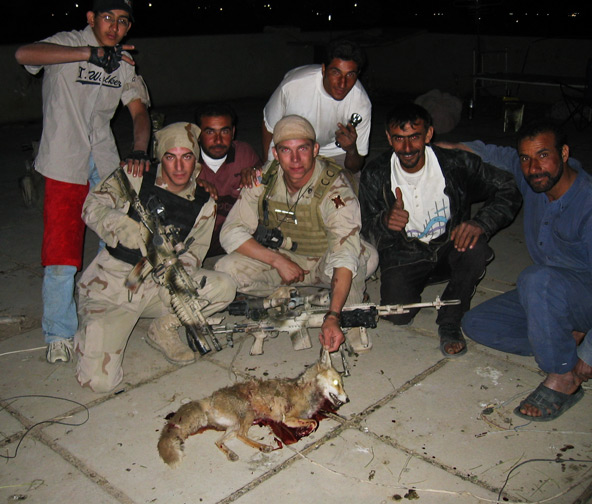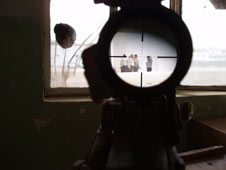
Iraq, 2005. After killing a fox which was stalking the chickens of an Iraqi family. Romero posed with his kill. Joe was happy that he helped them out and said this was one of his best moments in the country. In other pictures, he is sitting with the men eating a feast.
Photo: Unknown
A day after I started the embed with the company in Amariyah, I was riding in a Humvee taking a tour of the neighborhood, when we suddenly turned down Rafaee street and then turned right on Amel Al Shabi, the same intersection where Salihee was killed. The patrol had gone over the exact spot, so there was no doubt that this was not only the right company, but the same platoon. Not long after that, a number of soldiers in the company came forward to tell me that they were nearby when Salihee was shot. I also knew from Ayman that snipers had fired on Salihee's car, so it came down to asking a young specialist from Louisiana who the snipers were in the unit. As we talked in his room and looked at video his buddies had shot during their tour in Iraq, the specialist gave me two names. One of the men worked in the company headquarters, the other sniper was still going on patrols. The next night, the 13th of July, I walked into the command post after dinner and recognized one of the men the young soldier had mentioned. The man was working on a notebook computer at a big table in the front room of the command post. We struck up a conversation.
A sniper with the 256th Brigade Combat Team.
The sniper was working the night shift at the command post. He was a tall, good- looking man who didn't have trouble getting girls back home. He showed me photographs on his computer, describing them in a deep Southern baritone. It was late and there weren't a lot of people around at that time of the night. Radios chirped and hissed in the next room with traffic from the patrols outside the wire as they made their way through the neighborhoods of western Baghdad. Satellite maps of the capital marked "SECRET" covered the walls of the trailer. It was a quiet night, and there were no roadside bombs or rocket attacks as the patrols called in their positions.
The soldier showed a picture of himself kneeling on the ground, surrounded by Iraqi men who were giving the camera the thumbs up. One of the young cousins was throwing a gang sign, his fingers spread out in a sideways "V." The men were smiling. One of the older brothers had his hand on the sniper's shoulder. In the foreground, laid out in front of the American, was his trophy, a dead fox.
The sniper explained to me that he had befriended the Shiite family in the photograph while his unit spent some days near the town of Taji. He was ordered to watch a road and posted on their roof. "They were so respectful and wanted to learn things about us, and learn about our culture. It was like we were very important people, stopping in at their house," he said with some amazement. It was one of his happiest memories of Iraq.
"On our last day at that position, while we were waiting to be extracted after midnight, we were sitting with the father, sons and cousins. Then the old man looked out and saw a fox near his chickens. I looked through my night vision system and saw the fox on a roof on the far side of a courtyard. The father said, 'Would you mind shooting the animal that is killing our chickens?' I said, 'Not a problem.' So I fired and it disappeared, but they didn't believe I hit it. I told the kid to go out and see for himself and he went out there and came back with the fox, smiling. The old man was so happy."
The sniper said he wanted to go back to see how the family was doing, but the unit changed locations and he couldn't keep his promise to return. He brought up more photographs of his sniper positions, and told me he could hit a quarter at 300 meters. It is a distance of nearly a thousand feet. The sniper also told me his first name was Joe.
Back home, Joe hunts white-tailed deer with a bow and arrows he carves out of cedar shafts. "You have to know how to stand," he said. "You only have 20 yards." Like most of the men in his unit who are from the deep South, he can talk about the woods for hours, and his descriptions of his favorite places are unusually vivid, but the world beyond the forests and bayous, the chain of command and military politics, makes him uncomfortable. In the war zone, Joe remains close to the noncommissioned officers he trusts and avoids officers as much as he can. Joe is the son of a fighter pilot who died a year after he returned from Vietnam. There have been soldiers in his family for generations. When he started talking, I could see that he was struggling to make sense of his experiences in Iraq.
Joe went through the pictures on his laptop one by one, talking about near misses where his hiding place was nearly discovered, and the hot days where he had to lie perfectly still while Iraqis walked a few feet away from his position.
We looked at photographs of Joe crouching in fields, surrounded by tall grass where he can barely be distinguished in his camouflage suit. In many of the shots, he's flipping off the camera. "That's just something we do," he told me. "I don't think you can use any of those pictures," he said and laughed.
Then he brought up a photograph of a white Daewoo Espero sedan on a Baghdad street. The sedan had a single bullet hole in the driver's side of the windshield. Behind the wheel there was a lifeless man, slumped in the seat with a shattered skull and a torrent of blood staining his shirt. The image carried a sudden shock of recognition and despair. The dead man behind the wheel of the car was my friend and colleague, Yasser Salihee.
The Editor and Publisher called the Victim and the Killer one of the most remarkable stories to come out of Iraq.
 LEAD IMAGE: Iraq, 2005. Joe Romero looks through the sight of his sniper rifle at a group of men.
LEAD IMAGE: Iraq, 2005. Joe Romero looks through the sight of his sniper rifle at a group of men.Photo: Sergeant Joe Romero
© Phillip Robertson, 2009-2014.
